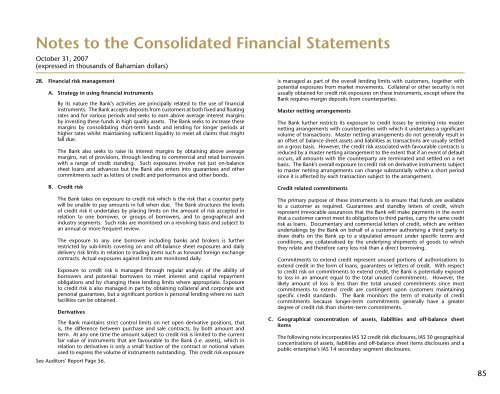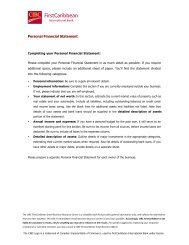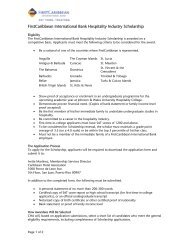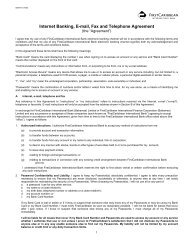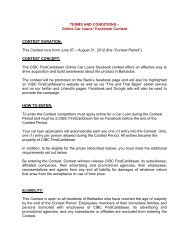Bahamas - FirstCaribbean International Bank
Bahamas - FirstCaribbean International Bank
Bahamas - FirstCaribbean International Bank
You also want an ePaper? Increase the reach of your titles
YUMPU automatically turns print PDFs into web optimized ePapers that Google loves.
Notes to the Consolidated Financial Statements<br />
October 31, 2007<br />
(expressed in thousands of Bahamian dollars)<br />
28. Financial risk management<br />
A. Strategy in using financial instruments<br />
By its nature the <strong>Bank</strong>’s activities are principally related to the use of financial<br />
instruments. The <strong>Bank</strong> accepts deposits from customers at both fixed and floating<br />
rates and for various periods and seeks to earn above average interest margins<br />
by investing these funds in high quality assets. The <strong>Bank</strong> seeks to increase these<br />
margins by consolidating short-term funds and lending for longer periods at<br />
higher rates whilst maintaining sufficient liquidity to meet all claims that might<br />
fall due.<br />
The <strong>Bank</strong> also seeks to raise its interest margins by obtaining above average<br />
margins, net of provisions, through lending to commercial and retail borrowers<br />
with a range of credit standing. Such exposures involve not just on-balance<br />
sheet loans and advances but the <strong>Bank</strong> also enters into guarantees and other<br />
commitments such as letters of credit and performance and other bonds.<br />
B. Credit risk<br />
The <strong>Bank</strong> takes on exposure to credit risk which is the risk that a counter party<br />
will be unable to pay amounts in full when due. The <strong>Bank</strong> structures the levels<br />
of credit risk it undertakes by placing limits on the amount of risk accepted in<br />
relation to one borrower, or groups of borrowers, and to geographical and<br />
industry segments. Such risks are monitored on a revolving basis and subject to<br />
an annual or more frequent review.<br />
The exposure to any one borrower including banks and brokers is further<br />
restricted by sub-limits covering on and off-balance sheet exposures and daily<br />
delivery risk limits in relation to trading items such as forward foreign exchange<br />
contracts. Actual exposures against limits are monitored daily.<br />
Exposure to credit risk is managed through regular analysis of the ability of<br />
borrowers and potential borrowers to meet interest and capital repayment<br />
obligations and by changing these lending limits where appropriate. Exposure<br />
to credit risk is also managed in part by obtaining collateral and corporate and<br />
personal guarantees, but a significant portion is personal lending where no such<br />
facilities can be obtained.<br />
Derivatives<br />
The <strong>Bank</strong> maintains strict control limits on net open derivative positions, that<br />
is, the difference between purchase and sale contracts, by both amount and<br />
term. At any one time the amount subject to credit risk is limited to the current<br />
fair value of instruments that are favourable to the <strong>Bank</strong> (i.e. assets), which in<br />
relation to derivatives is only a small fraction of the contract or notional values<br />
used to express the volume of instruments outstanding. This credit risk exposure<br />
See Auditors’ Report Page 56.<br />
is managed as part of the overall lending limits with customers, together with<br />
potential exposures from market movements. Collateral or other security is not<br />
usually obtained for credit risk exposures on these instruments, except where the<br />
<strong>Bank</strong> requires margin deposits from counterparties.<br />
Master netting arrangements<br />
The <strong>Bank</strong> further restricts its exposure to credit losses by entering into master<br />
netting arrangements with counterparties with which it undertakes a significant<br />
volume of transactions. Master netting arrangements do not generally result in<br />
an offset of balance sheet assets and liabilities as transactions are usually settled<br />
on a gross basis. However, the credit risk associated with favourable contracts is<br />
reduced by a master netting arrangement to the extent that if an event of default<br />
occurs, all amounts with the counterparty are terminated and settled on a net<br />
basis. The <strong>Bank</strong>’s overall exposure to credit risk on derivative instruments subject<br />
to master netting arrangements can change substantially within a short period<br />
since it is affected by each transaction subject to the arrangement.<br />
Credit related commitments<br />
The primary purpose of these instruments is to ensure that funds are available<br />
to a customer as required. Guarantees and standby letters of credit, which<br />
represent irrevocable assurances that the <strong>Bank</strong> will make payments in the event<br />
that a customer cannot meet its obligations to third parties, carry the same credit<br />
risk as loans. Documentary and commercial letters of credit, which are written<br />
undertakings by the <strong>Bank</strong> on behalf of a customer authorising a third party to<br />
draw drafts on the <strong>Bank</strong> up to a stipulated amount under specific terms and<br />
conditions, are collateralised by the underlying shipments of goods to which<br />
they relate and therefore carry less risk than a direct borrowing.<br />
Commitments to extend credit represent unused portions of authorisations to<br />
extend credit in the form of loans, guarantees or letters of credit. With respect<br />
to credit risk on commitments to extend credit, the <strong>Bank</strong> is potentially exposed<br />
to loss in an amount equal to the total unused commitments. However, the<br />
likely amount of loss is less than the total unused commitments since most<br />
commitments to extend credit are contingent upon customers maintaining<br />
specific credit standards. The <strong>Bank</strong> monitors the term of maturity of credit<br />
commitments because longer-term commitments generally have a greater<br />
degree of credit risk than shorter-term commitments.<br />
C. Geographical concentration of assets, liabilities and off-balance sheet<br />
items<br />
The following note incorporates IAS 32 credit risk disclosures, IAS 30 geographical<br />
concentrations of assets, liabilities and off-balance sheet items disclosures and a<br />
public enterprise’s IAS 14 secondary segment disclosures.<br />
85


